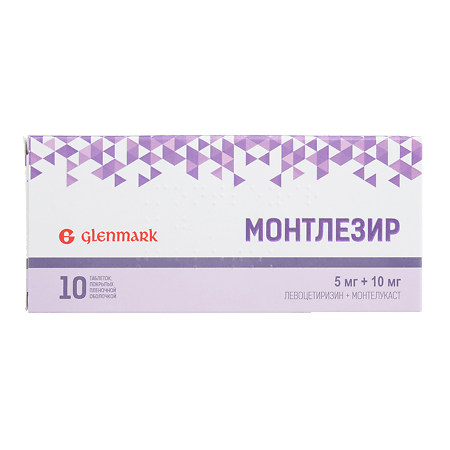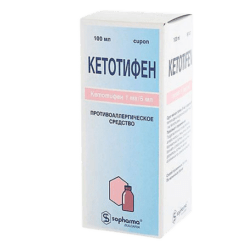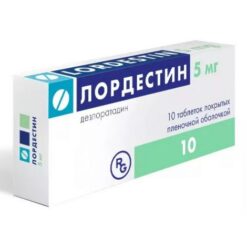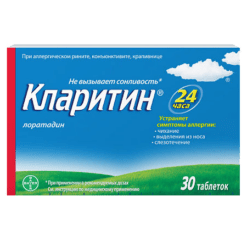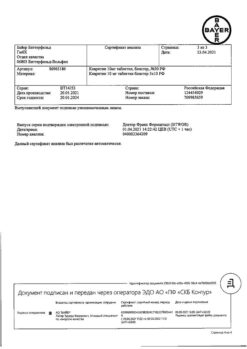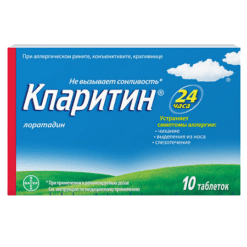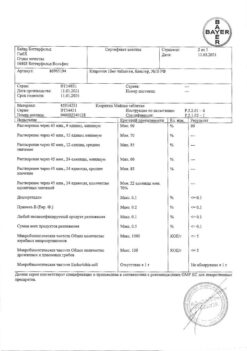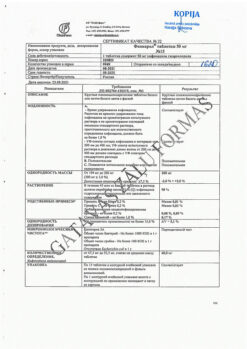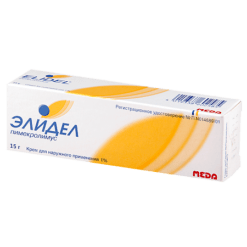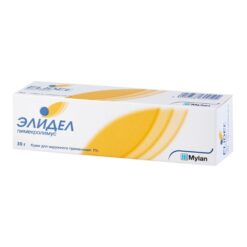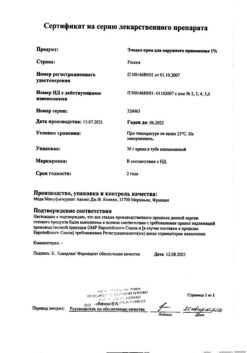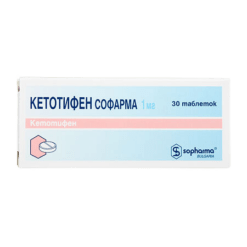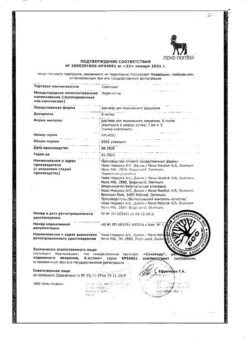No products in the cart.
Description
A combined anti-allergic agent.
The drug is a combination of montelukast (leukotriene receptor blocker) and levocetirizine (H1-histamine receptor blocker).
Montelukast selectively inhibits the CysLT receptors of the cysteinyl leukotrienes of the airway epithelium. Cysteinyl leukotriene type 1 receptors (CysLT receptors) are present in the human airway, including in bronchial smooth muscle cells, macrophages and other pro-inflammatory cells (including eosinophils and some myeloid stem cells).
The cysteinyl leukotrienes (LTC4, LTD4, LTE4) belong to the class of eicosanoids formed from arachidonic acid, and are mediators of inflammation formed in various cells of the body, including mast cells.Mast cells and eosinophils.
Cysteinyl leukotrienes correlate with the pathophysiology of bronchial asthma and allergic rhinitis. In allergic rhinitis, the release of cysteinyl leukotrienes from the anti-inflammatory cells of the nasal mucosa during the early and late phases of the allergic reaction occurs after allergen exposure, which manifests as symptoms of allergic rhinitis.
In an intranasal test with cysteinyl leukotrienes, an increase in symptoms of nasal obstruction has been demonstrated. Montelukast binds with high affinity and selectivity to CysLT1 receptors and reduces the number of eosinophils in peripheral blood, in the airways.
Levocetirizine is a blocker of histamine H1 receptors, R-enantiomer of cetirizine; competitive histamine antagonist; affinity to histamine H1 receptors is 2 times higher than that of cetirizine.
Levocetirizine influences the histamine-dependent stage of allergic reactions; it reduces migration of eosinophils, decreases vascular permeability, limits release of inflammatory mediators and cytokines (VCAM-1 and others).
Levocetirizine prevents and facilitates the development of allergic reactions, has antiexudative, antipruritic effects; it has practically no anticholinergic and antiserotonin action. In therapeutic doses has almost no sedative effect.
The action begins 12 minutes after a single dose in 50% of patients, after 1 hour in 95% of patients and lasts for 24 hours.
Pharmacokinetics
Indications
Indications
Treatment of symptoms of year-round (persistent) and seasonal (intermittent) allergic rhinitis.
Pharmacological effect
Pharmacological effect
Combined antiallergic agent.
for The drug is a combination of montelukast (leukotriene receptor blocker) and levocetirizine (H1-histamine receptor blocker).
Montelukast selectively inhibits CysLT receptors of cysteinyl leukotrienes in the respiratory tract epithelium. Cysteinyl leukotriene receptors type 1 (CysLT receptors) are present in the human respiratory tract, incl. in bronchial smooth muscle cells, macrophages and other proinflammatory cells (including eosinophils and some myeloid stem cells).
Cysteinyl leukotrienes (LTC4, LTD4, LTE4) belong to the class of eicosanoids formed from arachidonic acid and are mediators of inflammation formed in various cells of the body, including. in mast cells and eosinophils.
Cysteinyl leukotrienes correlate with the pathophysiology of bronchial asthma and allergic rhinitis. In allergic rhinitis, after exposure to an allergen, cysteinyl leukotrienes are released from anti-inflammatory cells of the nasal mucosa during the early and late phases of the allergic reaction, which is manifested by symptoms of allergic rhinitis.
An intranasal test with cysteinyl leukotrienes demonstrated an increase in symptoms of nasal obstruction. Montelukast binds with high affinity and selectivity to CysLT1 receptors and reduces the number of eosinophils in the peripheral blood and respiratory tract.
Levocetirizine is a histamine H1 receptor blocker, R-enantiomer of cetirizine; competitive histamine antagonist; the affinity for histamine H1 receptors is 2 times higher than that of cetirizine.
Levocetirizine has an effect on the histamine-dependent stage of allergic reactions; reduces the migration of eosinophils, reduces vascular permeability, limits the release of inflammatory mediators and cytokines (VCAM-1 and others).
Levocetirizine prevents the development and alleviates the course of allergic reactions, has an antiexudative and antipruritic effect; has virtually no anticholinergic and antiserotonin effects. In therapeutic doses it has virtually no sedative effect.
The action begins 12 minutes after taking a single dose in 50% of patients, after 1 hour in 95%, and continues for 24 hours.
Pharmacokinetics
Special instructions
Special instructions
Montelukast
In rare cases, systemic eosinophilia may occur in patients taking drugs to treat asthma, including montelukast, sometimes accompanied by clinical manifestations of vasculitis and Churg-Strauss syndrome. This condition is usually treated with systemic corticosteroids.
Such cases are usually, but not always, associated with dose reduction or discontinuation of oral corticosteroids. Clinicians should be aware of the possibility that patients may experience eosinophilia, vasculitic rash, worsening pulmonary symptoms, cardiac complications, and/or neuropathy.
Patients with a documented allergy to acetylsalicylic acid and other non-steroidal anti-inflammatory drugs (NSAIDs) should not take these drugs during treatment with montelukast, since it, while improving respiratory function in patients with allergic bronchial asthma, however, cannot completely prevent bronchoconstriction caused by NSAIDs.
Neuropsychiatric disorders have been described in patients taking montelukast. Given that these symptoms could be caused by other factors, it is unknown whether they are related to montelukast.
Physicians should discuss these adverse events with patients and/or their parents/guardians. Patients and/or their parents/guardians should be advised that if such symptoms occur, they should notify their physician.
Levocetirizine
It is not recommended to take ethanol during treatment with the drug.
Impact on the ability to drive vehicles and operate machinery
No studies have been conducted on the effect of the drug on the ability to drive vehicles and operate machinery.
During the treatment period, care must be taken when driving vehicles and engaging in other potentially hazardous activities that require increased concentration and speed of psychomotor reactions, as the drug can cause weakness, drowsiness and dizziness.
Active ingredient
Active ingredient
Levocetirizine, Montelukast
Composition
Composition
1 tab.:
Active ingredient of 1st layer: levocetirizine dihydrochloride 5.0 mg;
Excipients of the 1st layer: lactose monohydrate (Tablettose 100) 63.5 mg, microcrystalline cellulose (Avicel PH 102) 30.2 mg, colloidal silicon dioxide 0.3 mg, magnesium stearate 1.0 mg;
Active ingredient 2 layers: montelukast sodium 10.4 mg, equivalent to montelukast 10.0 mg;
Excipients 2 layers: lactose monohydrate (Farmatose 200M) 89.3 mg, microcrystalline cellulose (Avicel PH 101) 83.2 mg, yellow iron oxide dye (iron oxide yellow) 0.1 mg, croscarmellose sodium 13.0 mg, hyprolose (hydroxypropylcellulose) 3.0 mg, magnesium stearate 1.0 mg;
Film coating: Opadry yellow (Opadry yellow 13B52204) 6.0 mg (hypromellose 6cP (HPMC2910) 3.75 mg, titanium dioxide 1.4556 mg, macrogol-400 0.375 mg, iron dye yellow oxide (iron oxide yellow) 0.357 mg, polysorbate-80 0.060 mg, red iron oxide dye (iron oxide red) 0.0024 mg).
Pregnancy
Pregnancy
Adequate and strictly controlled clinical studies on the safety of the drug during pregnancy have not been conducted.
The use of the drug during pregnancy is contraindicated.
There is no data on the excretion of montelukast into breast milk in humans.
Levocetirizine is excreted in breast milk. Therefore, if it is necessary to use the drug during lactation, it is recommended to stop breastfeeding.
Contraindications
Contraindications
Hypersensitivity to montelukast, levocetirizine (including piperazine derivatives), as well as to other components of the drug.
Lactase deficiency, lactose intolerance, glucose-galactose malabsorption.
End-stage renal failure (creatinine clearance below 10 ml/min).
Children under 15 years of age (due to limited data on safety and effectiveness).
Pregnancy and breastfeeding period.
With caution:
Chronic renal failure (dosage regimen adjustment required); old age (possibly decreased glomerular filtration rate); patients with spinal cord injury, prostatic hyperplasia, or other predisposing factors to urinary retention, since levocetirizine may increase the risk of urinary retention; when used simultaneously with alcohol.
Side Effects
Side Effects
The adverse events listed below are distributed according to the frequency of occurrence according to the following gradation: very often (≥ 1/10), often (from ≥ 1/100 to
Montelukast
Disorders of the blood and lymphatic system: frequency unknown – increased tendency to bleeding, thrombocytopenia.
Immune system disorders: rarely – hypersensitivity reaction, including anaphylaxis, very rarely – eosinophilic infiltration of the liver.
Mental disorders: frequency unknown – agitation, including aggressive behavior or hostility, anxiety, depression, disorientation, pathological dreams, hallucinations, insomnia, irritability, restlessness, somnambulism, suicidal thoughts and behavior (suicidality), tremor, attention and memory disorders.
Nervous system disorders: rarely – headache, dizziness, drowsiness; very rarely – convulsions; frequency unknown – paresthesia/hypesthesia.
Cardiac disorders: frequency unknown – palpitations.
Disorders of the respiratory system, chest and mediastinal organs: rarely – nosebleeds, frequency unknown – upper respiratory tract infections, pharyngitis, cough, sinusitis, rhinorrhea, Churg-Strauss syndrome.
Gastrointestinal disorders: rarely – heartburn, belching, abdominal pain; frequency unknown – diarrhea, vomiting, dyspepsia, nausea, constipation, pancreatitis, dry mouth.
Disorders of the liver and biliary tract: rarely – increased activity of liver transaminases in the blood serum (alanine aminotransferase (ALT), aspartate aminotransferase (AST)), very rarely – hepatitis (including cholestatic, hepatocellular and mixed liver lesions).
Disorders of the skin and subcutaneous tissues: rarely – skin rash, urticaria; frequency unknown – angioedema, the appearance of ecchymosis, erythema nodosum, erythema multiforme, pruritus.
Musculoskeletal and connective tissue disorders: rarely – arthralgia; frequency unknown – myalgia, including muscle spasms.
Renal and urinary tract disorders: frequency unknown – enuresis in children.
General disorders and disorders at the injection site: rarely – asthenia (weakness)/fatigue; frequency unknown – edema, pyrexia, thirst.
Levocetirizine
Immune system disorders: frequency unknown – hypersensitivity reactions, including anaphylactic reactions.
Metabolic and nutritional disorders: frequency unknown – increased appetite, increased body weight.
Mental disorders: often – headache, drowsiness, fatigue; infrequently – asthenia; frequency unknown – anxiety, aggression, agitation, insomnia, hallucinations, depression, suicidal thoughts.
Nervous system disorders: frequency unknown – convulsions, dural sinus thrombosis, paresthesia, dizziness, fainting, tremor, dysgeusia (taste disturbance).
Visual disorders: frequency unknown – visual impairment, diplopia, inflammation, blurred vision.
Hearing and labyrinthine disorders: frequency unknown – vertigo.
Cardiac disorders: frequency unknown – tachycardia, angina, palpitations.
Vascular disorders: frequency unknown – jugular vein thrombosis.
Disorders of the respiratory system, chest and mediastinal organs: frequency unknown – dyspnea, increased symptoms of rhinitis.
Gastrointestinal disorders: often – dry mouth; infrequently – abdominal pain; frequency unknown – nausea, diarrhea, vomiting.
Disorders of the liver and biliary tract: frequency unknown – hepatitis.
Skin and subcutaneous tissue disorders: frequency unknown – angioedema, drug-resistant erythema, rash, itching, urticaria, hypotrichosis, fissures, photosensitivity.
Musculoskeletal and connective tissue disorders: frequency unknown – muscle pain, arthralgia.
Renal and urinary tract disorders: frequency unknown – dysuria, urinary retention, urge to urinate.
Laboratory and instrumental data: frequency unknown – changes in liver function tests.
Other: frequency unknown – cross-reactivity, peripheral edema.
If any of the side effects indicated in the instructions get worse, or you notice any other side effects not listed in the instructions, tell your doctor.
Interaction
Interaction
Montelukast
Montelukast can be prescribed together with other drugs traditionally used for the prevention and long-term treatment of bronchial asthma and/or allergic rhinitis.
The recommended therapeutic dose of montelukast does not have a clinically significant effect on the pharmacokinetics of the following drugs: theophylline. prednisone, prednisone, oral contraceptives (ethinyl estradiol/norethisterone 35/1), terfenadine, digoxin and warfarin.
The AUC value decreases when taking phenobarbital concomitantly (by approximately 40%), however, no adjustment of the montelukast dosage regimen is required. Since montelukast is metabolized by the CYP3A4 isoenzyme, caution should be exercised if montelukast is co-administered with drugs that induce the CYP3A4 isoenzyme, such as phenytoin, phenobarbital and rifampicin. However, no change in the dose of montelukast is required.
In vitro studies have shown that montelukast is a potential inhibitor of the CYP 2C8 isoenzyme, however, data from clinical drug-drug interaction studies involving montelukast and rosiglitazone (a pre-substrate of medicinal products primarily metabolized by the CYP 2C8 isoenzyme) have shown that doses of montelukast do not inhibit CYP 2C8 isoenzymes in vivo.
Therefore, montelukast does not have a significant effect on the metabolism of drugs metabolized by this enzyme (for example, paclitaxel, rosiglitazone and repaglinide).
Gemfibrozil (an inhibitor of CYP 2C8 and 2C9) increases the effect of systemic exposure to montelukast by 4.4 times. However, the effect of gemfibrozil on the systemic exposure of montelukast may not be considered clinically significant based on safety data at doses of montelukast greater than the approved dose of 10 mg. Therefore, when co-administered with gemfibrozil, no dose adjustment of montelukast is required.
Co-administration of itraconazole, a strong CYP3A4 inhibitor, with gemfibrozil and montelukast did not result in an additional increase in the effect of systemic exposure to montelukast.
Levocetirizine
When studying the drug interactions of cetirizine racemate with phenazone, pseudoephedrine, cimetidine, ketoconazole, erythromycin, azithromycin, glipizide and diazepam, no clinically significant adverse interactions were identified.
Theophylline (400 mg/day) reduces the total clearance of levocetirizine by 16%, while the kinetics of theophylline does not change.
A study with simultaneous administration of ritonavir (600 mg 2 times a day) and cetirizine (10 mg per day) showed that the exposure of cetirizine increased by 40%, and the exposure of ritonavir changed slightly (-11%).
Combined use with macrolides or ketoconazole did not cause significant changes in the ECG.
In some cases, with simultaneous use of levocetirizine with alcohol or drugs that have a suppressive effect on the central nervous system (CNS), their effect on the central nervous system may be enhanced, although it has not been proven that cetirizine racemate potentiates the effect of alcohol.
Overdose
Overdose
There have been no reports of drug overdose. However, there is evidence of overdose with individual components of the drug.
Montelukast
Symptoms: The most common adverse events were thirst, drowsiness, vomiting, psychomotor agitation, headache and abdominal pain.
Treatment: treatment is symptomatic. There is no information on specific treatment for montelukast overdose. There is no data on the possibility of removing montelukast by peritoneal dialysis and hemodialysis.
Levocetirizine
Symptoms: drowsiness (in adults), agitation and anxiety, followed by drowsiness (in children).
Treatment: gastric lavage, taking activated carbon, symptomatic therapy. There is no specific antidote. Hemodialysis is ineffective.
Storage conditions
Storage conditions
Store in a place protected from light at a temperature not exceeding 25 °C.
Keep out of the reach of children.
Shelf life
Shelf life
2 years.
Do not use the drug after the expiration date.
Manufacturer
Manufacturer
Glenmark Pharmaceuticals Ltd, India
Additional information
| Shelf life | 2 years. Do not use after the expiration date. |
|---|---|
| Conditions of storage | Store in the dark place at a temperature not exceeding 25 °С. Store out of the reach of children. |
| Manufacturer | Glenmark Pharmaceuticals Ltd, India |
| Medication form | pills |
| Brand | Glenmark Pharmaceuticals Ltd |
Related products
Buy Montlezir, 5 mg+10 mg 10 pcs with delivery to USA, UK, Europe and over 120 other countries.

